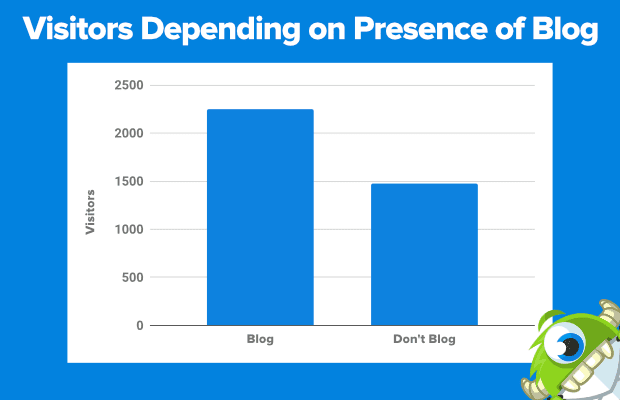57% of marketers say they’ve gained customers specifically through blogging. Bloggers who utilize blogging for marketing purposes see 13 times the ROI of businesses that don’t blog. A blog is one of the most popular content types for internet users to read, share, and learn.
 (Source)
(Source)
Business Benefits Of Implementing Blog On Your eCommerce Website
A regular blog posting on your website can phenomenally increase the traffic to your website. Blogs improve on-page SEO and off-page SEO by sharing blog posts across social media (link building). There are many more advantages of blog posting as below:
1. Increased traffic on your eCommerce website
2. Customer engagement & retention
3. Increased brand awareness
4. Increased marketing database: As prospects sign up for your blog newsletters, your database (which contains correct email addresses and phone numbers) grows. You can use this database for future and ongoing marketing campaigns.
5. Promotion of products and services through the relevant content
6. Corporate reputation building: By posting content that our clients find highly relevant and engaging, we establish our brand from a lot more than just a seller. As we post quality content on the website, we create an image of a consultant/expert.
Implementing a blog in Magento2
As clear from the above points, blogs are vital for any eCommerce website. However, the Magento eCommerce platform doesn’t support blogging features. Hence, we need to look for ways to extend the blogging functionality. We have two options for implementing a blog in Magento2.
1) Magento2 Blog Extensions
The Magento2 blog extensions can enable blogging functionality for any Magento2 store. They don’t have as many features as a WordPress blog. However, the blogs published through these extensions are capable of:
• Helping the website with SEO (keywords/content marketing/on-page SEO, link building)
• Make the website rank higher at Google. (Google loves blogs)
• Increasing customer engagement
• Enabling product sales through blogs
Once the blog extension is implemented, the blog section will appear on your Magento2 dashboard. Below are some Magento2 blog extensions that are free.
1. Blog MX for Magento2
An easy-to-use interface that lets you write or format blogs. Additionally, you can structure the blog with categories and tags.

2. Blog Extension by Magefan
You can use this extension to manage posts, categories, tags, comments, and authors directly from the admin panel. Additionally, it can create a news section in your store. Some of the key features of the Magefan blog extension are:
• Managed blog posts, categories, tags, and authors

• Blog comments.
• Related posts and related products
• Related posts in the product description
• Auto-publishing on Facebook
3. Better Blog by Mageplaza
This extension was installed over 94400 times during Q3 2016 – Q1 2020. It has 91 stars, 13 watchers, and 87 forks on GitHub.
2) WordPress blog integration
WordPress, for those who don’t know, is one of the most popular content management system solutions, it is free and written in PHP like Magento. WordPress is used by 41.4% of the top 10 million websites as of May 2021.
Although WordPress offers an extremely user-friendly interface that allows you to manage your blog content in possibly the simplest way, integrating WordPress with your Magento store has its pros and cons. Before we talk about that, let’s look at the options for WordPress blog and Magento2 integration. The easiest option is using a free extension like Fishpig that provides a free, simple, and effective integration.
Once you have installed the Fishpig extension, you will need to follow a few simple configuration steps, and within no time, your Magento2 store will be integrated with WordPress. The result may look somewhat like the below screenshot.

While the above method should give you everything you need for a basic WordPress integration, however, for advanced integration, there’s an alternate way to host our WordPress blog on a separate domain, a subdomain, or a subfolder. You can include a link on both your Magento2 store and your WordPress blog that helps the user navigate between the two platforms. The key here is to keep the user interfaces (mainly your header and footer) of your blog and your store as similar as possible for the user experience to be seamless. Or, you can opt for a more complicated blog configuration depending upon your business needs.
Pros and cons of Magento2 & WordPress Integration
Magento is a celebrated open-source eCommerce platform and so is WordPress. However, the integration of these two platforms has its share of pros and cons.
What are the advantages? WordPress features are incorporated into the eCommerce store. You can create a unique design utilizing its WordPress features.
What are the disadvantages? Since the blogs are not hosted on the Magento2 platform, customers do not see the shopping cart icon in the top header. To add items to their cart, they have to go back to the Magento2 store. The customers are inconvenienced. And, the sales are affected negatively.
Magento2 and WordPress are separate sites, so their databases differ. Users have to sign up twice (to store and blog). The user experience provided by this model is not optimal.
As with databases, the search query is also not synchronized. Thus, a customer searching for a product at the Magento store, finds only the products as search results, missing the related blog post(s).
The most important disadvantage is SEO. Since the blog is not on the Magento2 website, the blog/keyword-generated traffic to the Magento2 website will get missed upon. This won’t help our Magento2 website to rank higher on Google search results. However, you can share the link to your Magento2 store in the blog. This can aid off-page SEO.
Conclusion: Which method to choose?
Based on everything we have shared with you above, the answer to selecting your choice of a blog integration on your Magento store should be quite obvious, i.e. to go for Magento2 blog extensions. Though WordPress integration has better features for a professional blog presentation. But, it has more shortcomings than benefits. The challenges like SEO, Google search ranking, website security, and sales influence are inalienable.
Several Magento2 blog extensions come for free. Fast and easy to install, they also have convincing features. They have a positive impact on SEO, making your Magento2 website rank higher on Google search. Additionally, these extensions allow for sales maximization.
However, we would also like to point out that 42Works, over the years, has integrated WordPress blogs on many Magento2 stores. And, interestingly we have managed to resolve all the apparent burning issues making our customer’s Magento2 store (integrated with WordPress blogs) still rank high on Google search, driving huge website traffic, and accomplishing ambitious sales goals.
Amazed at how we accomplished that? Feel free to write to us at contact@42works.net


